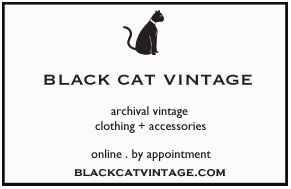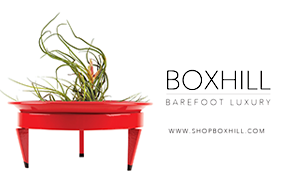Claudine Villardito turned childhood dress-up games into an expensive habit. And that habit became Black Cat Vintage, one of Tucson best-kept secrets.

Claudine Villardito: no more need for rifling through her mother's closet. Photo by Gillian Drummond
Visitors to the first annual Tucson Modernism Week will be in for a treat on opening night. A series of live 'sculptures' will pepper Chase Bank on Broadway Boulevard, the venue of the opening reception, the models dressed head-to-toe in clothing from the 1950s and 1960s.
The clothes come courtesy of Black Cat Vintage and its owner, Claudine Villardito, a woman whose childhood games of dress-up were different than those of most girls.
Claudine's mother, Tucson businesswoman Gale Maly, owned designer rags by the likes of Chanel and Christian Dior. Yet she let her daughter rifle through her clothes closet, which was when Claudine's passion for vintage began.
At college in Chicago, she would scour estate sales and soon was building up not only a collection, but a wealth of knowledge. "I would stop people in the street and ask about their clothes. I could tell vintage from twenty paces away," she says.
Claudine looks on vintage clothes collecting the same as she does saving cats (another of her habits). "I felt the urge to save these things because I didn't know what was about to happen to them. I anthropomorphize these clothes. It's got personality, a name, it's a friend and I know that it needs me."
Still, once she got married and settled in Phoenix, her husband told her enough was enough. Their closet was "the size of a phone booth" and they simply couldn't keep all the clothes. A bad car accident forced her to be sedentary for 18 months (she was studying veterinary medicine at the time), and she started researching vintage clothes preservation, archival and restoration.
Now back in Tucson, where she largely grew up, Claudine and Black Cat Vintage are appropriately situated in a 1957 building on Tucson Boulevard near Broadway. Here, on any given day you'll find a window display of polka dot and tiki swimwear, or a vignette with vintage sewing machine, kitchen appliances and I Love Lucy-themed mannequin. But despite the colorful store front, Black Cat Vintage does most of its trade online and is strictly by appointment only.
Claudine gently explains that she cannot sell to "a student wanting something for a costume party", that her beloved clothes will go only to serious collectors and wearers, people who will treat them right. It's that personal attachment thing, she says. "I try to seek out people who are going to enjoy them, so for the most part my clientele are enthusiasts. The second group of clients would be collectors themselves, who want to invest. And lastly there's the small clientele of costume directors. I'll give them a discount for the press it allows."
The clothes, hats and purses, ranging from 1920s flapper jackets up to 1970s items, hang in a tall warehouse-type space that resembles the wardrobe of a film set. Clients are seen individually, so that they have the whole space to themselves.
Quietly but persistently, Claudine has gained respect in the vintage community. Consignment store owners call her with the inside intel on an estate sale that's about to happen. Relatives of mid century designers call her wanting to re-build a clothing collection. Singer Lily Allen began her own vintage clothing store in London with pieces from Claudine. One of Claudine's pieces appeared in the second season of Mad Men.
Each item she purchases is cleaned and treated for pests. If repairs are needed, Claudine does the hand-sewing, or uses an expert machinist and a re-weaver. Her clothes carry not just history but gossip and, of course, glamour, from Hollywood Golden Age actresses to mid century socialites here and in Europe. Hanging in the racks is a dress by the designer of Grace Kelly's wedding dress. There's also an outfit by Jacques Fath, a prominent French fashion designer and contemporary of Christian Dior. Fath secretly copied one of his haute couture pieces for a French socialite and, realizing he wasn't supposed to reproduce it, refused to put his label on it. Instead he signed it on the hem.
Claudine's favorite is a dress custom-made for film star Betty Grable. In black satin with brown velvet flocking, it was a one-of-a-kind. The cost? A cool $12,000 - and even then only to the right person, says Claudine.
At Tucson Modernism Week's reception, Claudine and Sydney Ballesteros - who is fast making a name for herself here for her vintage fashion styling - will put on a fashion exhibition with a difference. They will dress six women in clothing popular between 1955 and 1965 and place them on pedestals around the Chase Bank building. "They will represent living sculptures evocative of the time being celebrated," says Claudine. There will even be placards on each pedestal, museum-style, explaining the clothing and its era. Claudine will be on hand to take questions - and you can bet she won't be stumped for answers.
Tucson Modernism Week's opening reception will be held at one of the city's landmark mid century buildings, Chase Bank at 3033 E. Broadway. The event is free but reservations are required.













































![IMG_0402[1]](http://i0.wp.com/3storymagazine.com/wp-content/uploads/2012/10/IMG_04021.jpg?resize=330%2C219)
![IMG_0405[1] 2](http://i2.wp.com/3storymagazine.com/wp-content/uploads/2012/11/IMG_04051-2.jpg?resize=420%2C570)


















